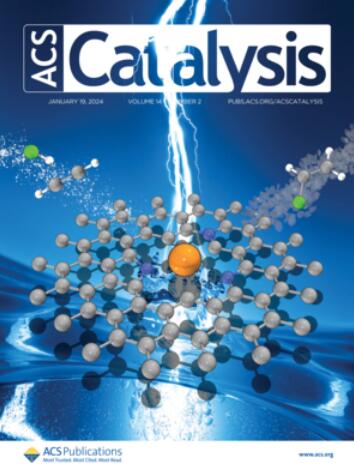ZrO2 Morphology-Dependent Cu–ZrO2 Interfacial Catalysis in CO2 Hydrogenation to Methanol Reaction
IF 13.1
1区 化学
Q1 CHEMISTRY, PHYSICAL
引用次数: 0
Abstract
In this study, we utilize monoclinic ZrO2 with different morphologies, including nanoparticulate ZrO2, rod-like ZrO2, and star-like ZrO2, to investigate the ZrO2 morphology effect on Cu–ZrO2 interfacial catalysis in the CO2 hydrogenation to methanol reaction. ZrO2 morphology strongly affects the structures, adsorption behaviors, and catalytic performance of Cu/ZrO2 catalysts. Various Cu/ZrO2 catalysts show very different catalytic selectivities, although their catalytic activities are rather poor. Bridged (bri-HCOO*) and monodentate (m-HCOO*) formate species form on Cu/ZrO2 catalysts during the CO2 hydrogenation to methanol reaction. Elementary surface reaction kinetics analysis using temporal in situ DRIFTS in combination with online mass spectrometry reveals elementary reaction activation energies of 61.3 ± 5 kJ/mol for bri-HCOO* hydrogenation mainly to methanol and 85.0 ± 14 kJ/mol for m-HCOO* hydrogenation mainly to CO. Meanwhile, the apparent activation energy for CH3OH and CO formations from the CO2 hydrogenation reaction catalyzed by Cu/nanoparticulate ZrO2 is 65.7 ± 4 and 118.6 ± 14 kJ/mol, respectively. These results suggest that bri-HCOO* should be the formate intermediate for methanol production by CO2 hydrogenation, and its hydrogenation reaction should be the rate-limiting step. Our findings clearly differentiate the reaction pathways of bri-HCOO* and m-HCOO* intermediates on Cu/ZrO2 during the CO2 hydrogenation to methanol reaction and demonstrate catalyst structural engineering in combination with elementary surface reaction kinetics analysis as a powerful strategy for fundamental studies of complex heterogeneous catalytic reactions.ZrO2形态依赖性Cu-ZrO2界面催化CO2加氢制甲醇反应
在本研究中,我们利用纳米ZrO2、棒状ZrO2和星形ZrO2等不同形态的单斜ZrO2,研究了ZrO2形态对Cu-ZrO2界面催化CO2加氢制甲醇反应的影响。ZrO2的形貌对Cu/ZrO2催化剂的结构、吸附行为和催化性能有很大影响。不同的Cu/ZrO2催化剂表现出不同的催化选择性,尽管它们的催化活性都很差。在Cu/ZrO2催化剂上,CO2加氢制甲醇反应形成了桥式(brii - hcoo *)和单齿状(m-HCOO*)甲酸酯。利用瞬时原位DRIFTS结合在线质谱分析的基本表面反应动力学分析表明,以甲醇为主的brii - hcoo *加氢反应的基本反应活化能为61.3±5 kJ/mol,以CO为主的m-HCOO*加氢反应的基本反应活化能为85.0±14 kJ/mol,同时Cu/纳米颗粒ZrO2催化CO2加氢反应生成CH3OH和CO的表观活化能分别为65.7±4和118.6±14 kJ/mol。这些结果表明,bri-HCOO*应该是CO2加氢制甲醇的甲酸中间体,其加氢反应应该是限速步骤。我们的研究结果清楚地区分了Cu/ZrO2在CO2加氢制甲醇反应过程中brii - hcoo *和m-HCOO*中间体的反应途径,并证明了将催化剂结构工程与基本表面反应动力学分析相结合是复杂非均相催化反应基础研究的有力策略。
本文章由计算机程序翻译,如有差异,请以英文原文为准。
求助全文
约1分钟内获得全文
求助全文
来源期刊

ACS Catalysis
CHEMISTRY, PHYSICAL-
CiteScore
20.80
自引率
6.20%
发文量
1253
审稿时长
1.5 months
期刊介绍:
ACS Catalysis is an esteemed journal that publishes original research in the fields of heterogeneous catalysis, molecular catalysis, and biocatalysis. It offers broad coverage across diverse areas such as life sciences, organometallics and synthesis, photochemistry and electrochemistry, drug discovery and synthesis, materials science, environmental protection, polymer discovery and synthesis, and energy and fuels.
The scope of the journal is to showcase innovative work in various aspects of catalysis. This includes new reactions and novel synthetic approaches utilizing known catalysts, the discovery or modification of new catalysts, elucidation of catalytic mechanisms through cutting-edge investigations, practical enhancements of existing processes, as well as conceptual advances in the field. Contributions to ACS Catalysis can encompass both experimental and theoretical research focused on catalytic molecules, macromolecules, and materials that exhibit catalytic turnover.
 求助内容:
求助内容: 应助结果提醒方式:
应助结果提醒方式:


